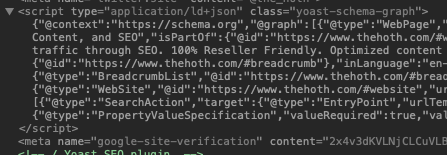AI search isn’t just a feature; it’s a filter.
Let’s elaborate.
LLMs and AI-driven search tools have reshaped the way people access information online. Most searches end in zero clicks, and Google’s organic results have been overtaken by AI Overviews.
At the same time, CTRs are dropping across the board while consumers have begun to trust AI’s product recommendations over those of their own families.
Because of these developments, brands that don’t align with AI’s semantic and contextual preferences risk becoming completely invisible. For example, imagine a finance blog that has truly remarkable content. It’s original, factually accurate, and genuinely helpful to its target audience.
Yet, their SEO is stuck in the past, and their entity recognition is abysmal. They go by several names online, have next to no brand mentions, and their website doesn’t use structured data.
Since they aren’t playing by LLMs’ rules, their brand won’t get cited or recommended at all.
In that sense, AI search tools have become the new gatekeepers of the internet.
They decide which brands get seen and which remain virtually unknown. Instead of catering to Google’s algorithm for better online visibility, marketers must meet the quality, formatting, and trust standards of LLMs.
In this guide, we’ll unpack how AI search filters out certain brands and how you can qualify to earn valuable AI citations and recommendations.
How LLMs Filter Information: A Peek Behind the Gate

There are several factors LLMs consider when determining which brands to cite and which to ignore.
They are:
- Entity recognition and linking
- Authority and credibility
- Contextual relevance
- User engagement and trust signals
- Structured data and consistent formatting
- Content quality and originality
You can think of these six factors as the gate keys to brand visibility in AI search. In other words, they’re the rules you must play by if you want your brand to appear in AI-generated responses.
If your online presence doesn’t embody all six keys, the gate will remain firmly shut, rendering your brand invisible to AI-driven discovery.
Let’s take a closer look at each one.
Gate key #1: Entity recognition and linking

For an AI to recommend your brand, it first has to know that you exist. LLMs use a process called entity understanding to recognize and disambiguate real-world entities like people, organizations, and concepts in text.
First, LLMs will use NER (named entity recognition) to detect mentions of your brand online and classify them as a specific entity type. In the case of your business or brand, you’d be categorized as an organization. The next step is to use EL (entity linking) to connect the mentions of your brand to entries in knowledge bases like Wikidata, schema.org, and Google’s Knowledge Graph.
Consistent branding across your content, backlinks, and citations helps ensure your mentions are recognized as a single, unique entity.
There are more than a few ways that this process can go wrong, including:
- Sparse brand mentions
- Inconsistent, nonexistent, or poorly formatted structured data
- Contextual misalignment (the brand does have brand mentions, but they’re irrelevant and off topic)
- Multiple names or aliases (like Ritz Catering Inc., Ritz Catering Corp., Ritz Catering Co.) can cause LLMs to treat each one as a separate entity
This is why optimizing your online presence for entity recognition is paramount for your success with AI search.
Gate key #2: Authority and credibility
Once an entity has been identified, LLMs must then determine if it’s a credible source worth citing. This is often referred to as the entity ranking process, but there’s no official term yet (it’s also referred to as entity authority scoring and entity salience weighting).
To assess how authoritative and trustworthy a brand is, LLMs will check:
- Online brand mentions and citations – both linked and unlinked
- Backlinks – with a strong emphasis on editorial quality and helpfulness
- Expert authorship signals – author biographies, author schema, and associated social media profiles, websites, and accolades (like speaking at conferences)
Research by Ahrefs uncovered that branded web mentions are the strongest visibility factor for AI tools, so it’s extremely important to build a buzz about your brand online.
Gate key #3: Contextual relevance

Next, the LLM determines the semantic relevance of a branded entity.
This delves far deeper than simple keyword matching.
To infer relevance, LLMs analyze not only your brand mentions but also the surrounding context. They’re sophisticated enough to fully comprehend every word on the page, so they’ll be able to tell if your brand was mentioned in a helpful, positive context (or if it randomly appears out of nowhere).
LLMs will pay attention to the topics, keywords, and related entities that occur alongside mentions of your brand.
This ensures that you’re a contextual ‘fit’ for a given topic, heightening the chances that LLMs will cite your content for related prompts.
Gate key #4: User engagement and trust signals
AI search tools also want to confirm that you have a positive brand sentiment before trusting you as a citable source.
For this, LLMs move beyond mainstream sources and check user trust signals like:
- Reviews from multiple platforms
- Community discussion (Reddit, Quora, niche forums)
- CTRs from search results
- User engagement metrics like dwell time
Brands with strong brand sentiment are more likely to appear in AI-generated results, so you need to actively manage your reputation.
Gate key #5: Structured data and concise formatting 
Your content should also be machine-readable so that it’s easy for LLMs to parse and disambiguate. Including semantic HTML and schema markup for products, authors, articles, and organizations is now a crucial, unskippable step.
The way you format your content also matters, because LLMs rely on structural clarity. This is because AI models don’t read the way humans do. Rather than reading one word at a time, they scan chunks of text (called tokens) for patterns, relationships, and clarity signals.
When parsing content, LLMs are on the hunt for semantic units like questions, answers, claims, and supporting facts.
If you structure your content with streamlined Q&As, clear headings, and concise bullet points, it makes your content virtually effortless for LLMs to parse.
Gate key #6: Content quality and originality 
The final gate key is the quality and originality of your branded content. In particular, LLMs prefer brands that have established topical authority in certain areas of expertise.
Topical authority is gained by consistently publishing content that covers the same topics in great detail. Developing interlinked content clusters is a fantastic way to go about this. The internal links make the connection between each piece clear, and you’ll get to comprehensively cover topics related to your business.
Originality is also crucial. LLMs do not want to cite generic content that regurgitates common information easily found online.
For this reason, you should not rely on AI-generated content to populate your website. Instead, ensure the content you produce contains first-hand experiences and unique insights.
How to Ensure Your Brand Isn’t Filtered Out

If you want to be one of the brands in your niche that AI tools actively recommend, you need to optimize your online presence for all six gate keys.
Here are some specific tactics you can use to establish strong entity clarity and credibility with AI search tools:
- Remain consistent with branding – You want LLMs to identify your brand as a distinct entity that’s relevant to your niche, so make sure you use consistent branding across the web. That means using the same brand name, logo, and tone across all your content, mentions, and backlinks.
- Earn relevant brand mentions and editorial backlinks – You should engage in things like digital PR to get related websites mentioning your brand in a positive light. Backlinks are also important, but they must be editorial in nature and serve a real purpose (like linking to a helpful guide, relevant product, or free tool).
- Control your brand’s narrative (own your brand mentions) – Beyond simply earning brand mentions, they should all tell the same tale. By that, we mean your brand mentions should reinforce your brand’s identity and narrative. This includes auditing and editing your existing brand mentions to ensure consistency.
- Always include structured data – Every page on your website should contain semantic HTML and schema markup. This aids the parsing process and removes all ambiguity when LLMs scan your content.
- Manage your brand’s reviews and reputation – Since social proof matters to LLMs, you need to maintain a positive brand sentiment. Bear in mind, this doesn’t mean deleting all negative reviews or forms of criticism. Instead, responding to reviews and resolving issues should be your go-to move. At the same time, you should encourage your satisfied customers to leave you positive reviews.
- Develop topical authority through expert content – A vast library of high-quality content tells LLMs that you’re an authority figure and expert source for certain topics. Aim to flesh out the topics related to your products and services in as much detail as possible. Once again, we recommend developing interlinked content clusters.
- Verify and maintain your brand’s entries in common knowledge bases – During the entity linking process, LLMs will check your brand’s entries in common knowledge bases like Wikidata and Crunchbase. Accordingly, you must ensure that these entries are accurate and up to date. If you notice something is off, either correct it manually or request that it be changed.
These optimizations will help you pass through the AI visibility gate, paving the way for content citations and direct brand recommendations.
Final Thoughts: AI Search as a Brand Filter
To wrap up, online visibility is no longer a spectrum; it’s a strict binary. Either you’re authoritative enough for AI search tools to cite you, or you’re completely ignored.
Therefore, AI search optimization centers around convincing LLMs that you’re a credible, trusted source worthy of mentioning to its users.
Are you curious about how your online presence stacks up to the AI visibility gate?
Get in touch to find out your AI Visibility Readiness Score.

















































































































































